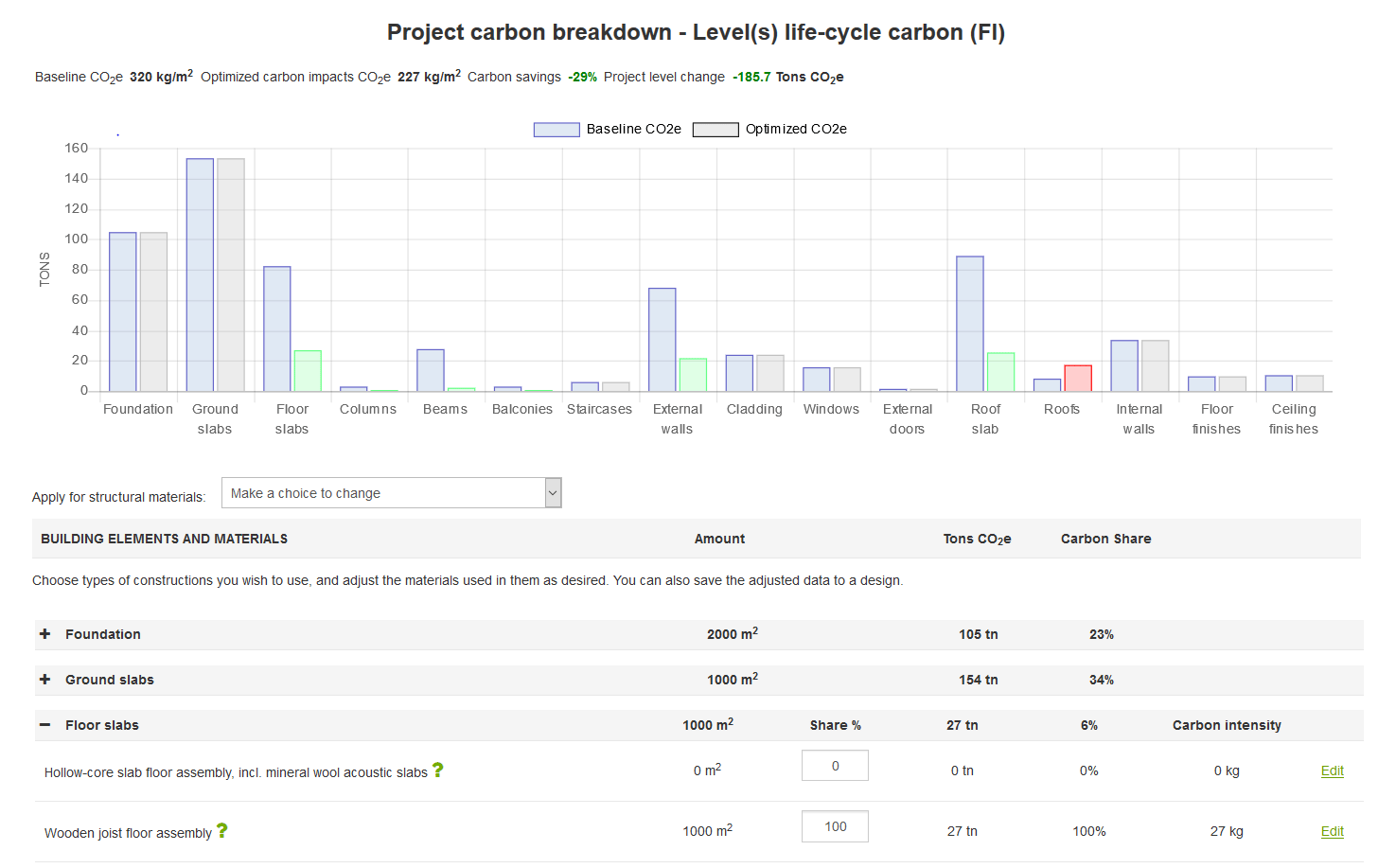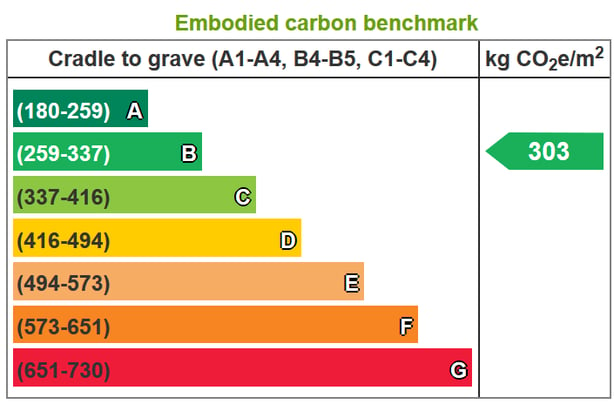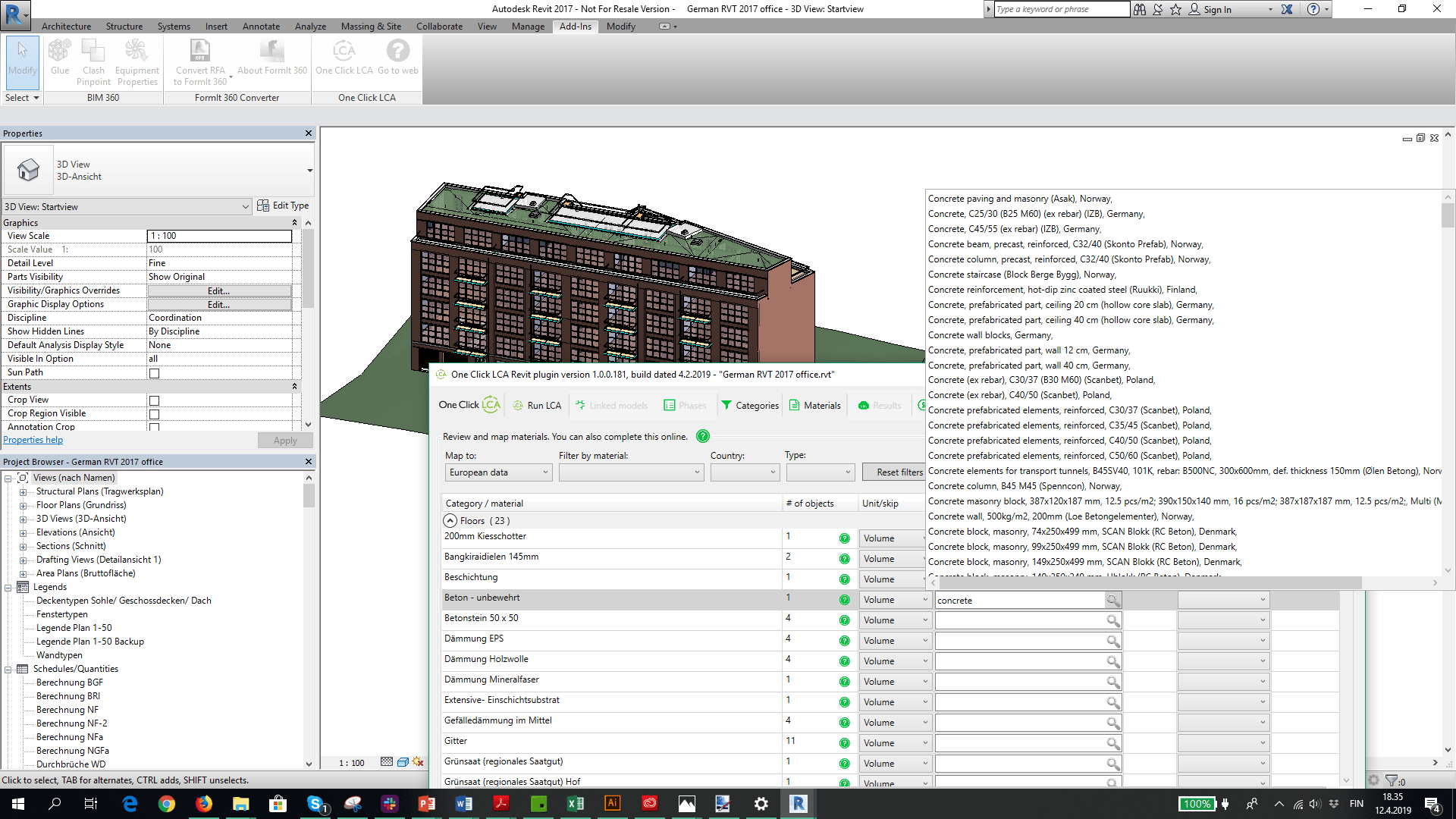
Image: Enter source or image description here
Why carbon footprint calculations matter and how they are performed in practice?
This article first appeared on Wood Magazine Feb 2019. You can read the full magazine here.
Why is it important to assess the carbon footprint of buildings?
Over their life time, buildings are responsible for approximately 40 % of global greenhouse gas emissions(1) and use approximately half of the materials consumed in the EU(2). To address the huge impact of the built environment, public sector requirements and legislation initiatives and private sector requirements for reaching carbon neutrality are stimulating a growing market demand for low carbon buildings.
The life cycle carbon footprint of a building consists of the sum of impacts from material extraction and manufacturing processes, transportation, construction works, maintenance, repairs, and replacement of materials during the building’s life cycle, consumption of energy and water and knock down and end-of -life processing of building materials.
Currently, the highest share of a building’s carbon footprint is caused by its operational energy consumption. However, results from a wide variety of research also reveal that the embodied emissions from construction materials account for significant life cycle impacts(3). As the emissions from energy use decrease due to the decarbonization of the energy supply as well as increase in energy efficiency, the impact of embodied carbon becomes more relevant. For instance, in Norway and Sweden, the impacts of other life cycle stages than operational energy use are responsible for the majority of life cycle impacts for new buildings (4,5).
Regulatory plans for life cycle carbon footprint
Until now the regulations and policies aiming towards mitigation of global warming potential of buildings in Finland and internationally have mainly concentrated on operational energy use. These regulations sought to reduce carbon emissions through energy certificates and efficiency requirements. However, this has proven to be of limited help in some markets. When building energy legislation was updated in Finland in 2018, most of the economically feasible measures had already been implemented and the requirements for efficiency could only be modestly lowered. This means that reaching the emission reduction necessary to mitigate climate change will require new ideas.
A natural step is to move into regulating the whole life cycle of building including also the embodied emissions of materials from harvesting and manufacturing processes, construction works, maintenance, and end-of-life. Emission based regulation also leaves space for innovation and encourages industry to develop better products and solutions. The Finnish Ministry of Environment has announced their target to be having regulation based on whole building for life cycle carbon footprint by mid-2020. The aim is to introduce the new regulations step by step and test the requirements first in the public sector. Similar goals are also appearing around Europe. For instance, the Netherlands already has existing regulation based on building life cycle carbon footprint. And, many other governments, including Sweden and France, are planning to introduce similar regulations.
What is the basis of the calculations?
The assessment method for building life cycle carbon footprint is defined by European CEN / TC 350 Sustainability of construction works – family of standards. These include standards for building level assessment (EN 15978) and building product environmental product declarations which are leveraged in building level assessment. These standards form a common basis for the assessment of buildings across Europe and are leading global methodology for building life cycle assessment. Finnish Ministry of Environment is finalizing the national calculation method for building assessment. This based on the EN standards and gives further clarification inside the standard rules. The public hearing on the method was finalised in January 2019 and the work to finalize the method based on feedback is ongoing. The method is under test with real life building cases.

The Finnish methodology considers the emissions from building material manufacturing processes, construction works, material replacements, operational energy and end-of-life. The assessment is conducted over the required service life of the building or if not defined over a default service life of 50 years. The emission factors for operational energy are pre-defined and they consider the emission reductions over time due to agreed commitments by the government. In addition to carbon footprint, the method includes the possibility to show the positive impacts building may have as a “Carbon handprint”. This includes for instance the benefits from material recycling after building life time, carbon reductions from concrete carbonation, carbon storage in bio-based materials, and selling out the excess renewable energy produced in building. Construction material manufacturers can show their own impacts by publishing environmental product declaration (EDP) according to EN 15804. The EPD can be published for individual product or for a group of products. In Finland EPDs are published by RTS. Environmental product declaration provides a standard way to communicate the environmental impacts of a product and to ensure the same information is consistent and accepted in different markets.

How carbon footprint can be calculated and reduced in real life cases?
A building’s life cycle carbon footprint is mainly defined during its design process. Once the building is ready for use, there will be limited opportunities to reduce emissions. As a consequence, taking action during the design process can steer the development of the building to achieve its optimal carbon footprint result. The decisions that define the end result are made through the design process and in best case, the carbon footprint would be steered through the whole design process to reach optimal result. For example, choosing the building site will define the available energy sources and foundation requirements based on soil. Also, the building geometry, efficient use, main structural material, and energy targets are often defined in concept stage. During the detailed design, the most important means to reduce emissions are energy efficiency and choosing renewable energy sources, using recycled and renewable materials, choosing materials with long service life, and minimizing material consumption. Also, choosing individual products matters, as similar materials may have over two times higher emissions when purchased from less efficient manufacturer. As a consequence, the information needed for carbon footprint calculation includes:
- Information on the building materials and their quantities for instance from drawings or building information model,
- Information on material manufacturing impacts and material service life
- Information on operational energy consumption and energy sources based on energy calculations
In addition, it is possible to use building specific information for material transportation, construction works, and material end-of-life or use default values as in the Finnish national method. The easiest, fastest, and most reliable method to assess building life cycle carbon footprint is to use ready assessment software that contains emission database and supports the chosen calculation method. Assessment software can enable doing assessments in early design stage when there is a limited amount of information and average data can serve as a substitute of missing data. Also, the assessment software can make the detailed design assessment a lot faster by automating data input from design software such as building information model. In addition, an assessment tool is the easiest way to ensure the quality of results. And, by guaranteeing the use of the right methodology, the assessor can focus on collecting building information and analysing the results to offer timely advice to the project team.

Which kind of services and tools are available in the market?
Currently, a tool for building life cycle assessment is available by One Click LCA Ltd who develops One Click LCA life cycle assessment tool for buildings (www.oneclicklca.com). This online platform contains tools for building carbon footprint, life cycle assessment, circular economy, life cycle cost analysis, and environmental product declarations. The platform has a comprehensive database with more than 10 000 building materials.
One Click LCA is currently used in more than 55 countries and its users include global leaders such as WSP, ARUP, Bouygues, Statsbygg, and BRE. In Finland, the tool is used for instance by Ramboll, Granlund, Optiplan, Sitowise, SRV, Stora Enso, the City of Helsinki, and many others.
The tool supports the Finnish national calculation method by the Ministry of Environment and other assessments such as LEED, BREEAM and RTS certifications. The tool enables the calculation of carbon during the early stages of the design process based on building size and type. In addition, this tool is been further developed in partnership with the Finnish Wood Industry Association and the material insulation industry to include all typical wood constructions and structural options available in the market. Finally, the tool supports all most commonly used design tools including Tekla, Revit, Archicad, IDA-ICE, Simplebim and Solibri, providing flexibility and efficiency to design teams looking at optimizing their project’s carbon footprint.
Sources:
1 World Green Building Council, 2019. https://www.worldgbc.org/thecommitment
2 Ruuska et al: Rakennusmateriaalien ympäristövaikutukset. Ympäristöministeriön raportteja 8 | 2013.
3 One Click LCA Oy: Tiekartta rakennuksen elinkaaren hiilijalanjäljen huomioimiseksi rakentamisen ohjauksessa. 2017, ladattavissa: https://www.ym.fi/fi-FI/Maankaytto_ja_rakentaminen/Rakentamisen_ohjaus/Vahahiilinen_rakentaminen/Tiekartta_rakennuksen_elinkaaren_hiilijalanjaljen_huomioimiseksi
4 Sitra: The Circular Economy, A Powerful Force for Climate Mitigation. 2018. https://www.sitra.fi/julkaisut/circular-economy-powerful-force-climate-mitigation/
5 One Click LCA Oy: The Embodied Carbon Review – Embodied carbon reduction in 100+ regulations and rating systems globally. 2018. https://www.oneclicklca.com/embodied-carbon-review/
6 Ympäristöministeriö, Vähähiilinen rakentaminen, https://www.ym.fi/fi-FI/Maankaytto_ja_rakentaminen/Rakentamisen_ohjaus/Vahahiilinen_rakentaminen


